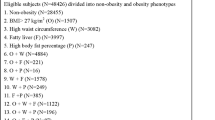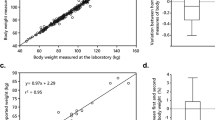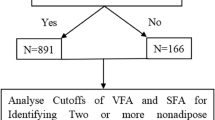Abstract
OBJECTIVE:
To investigate the relative contribution of total body fat mass (TFM) and intra-abdominal fat mass (IAFM) to metabolic consequences of obesity in offspring of type 2 diabetic parents.
DESIGN:
Cross-sectional study of 129 nondiabetic offspring of diabetic parents (59 men, 70 women, age 35.7±6.3 y, body mass index 26.2±4.6 kg/m2). Study subjects were grouped according to TFM (assessed with bioelectrical impedance) and IAFM (assessed with CT). Insulin sensitivity was assessed with the euglycemic hyperinsulinemic clamp, insulin secretion with the intravenous glucose tolerance test and energy expenditure with indirect calorimetry. Furthermore, C-reactive protein (CRP) and adiponectin levels were measured.
RESULTS:
Insulin resistance, low rates of oxidative and nonoxidative glucose disposal, high rates of lipid oxidation and reduced energy expenditure during hyperinsulinemia were associated with high IAFM, independently of TFM. Adiponectin level was reduced and CRP level increased in subjects with high IAFM.
CONCLUSIONS:
The metabolic changes relating to obesity are largely attributable to high IAFM, and are present even in normal weight subjects with high IAFM.
This is a preview of subscription content, access via your institution
Access options
Subscribe to this journal
Receive 12 print issues and online access
$259.00 per year
only $21.58 per issue
Buy this article
- Purchase on Springer Link
- Instant access to full article PDF
Prices may be subject to local taxes which are calculated during checkout



Similar content being viewed by others
References
Carr DB, Utzschneider KM, Hull RL, Kodama K, Retzlaff BM, Brunzell JD, Shofer JB, Fish BE, Knopp RH, Kahn SE . Intra-abdominal fat is a major determinant of the National Cholesterol Education Program Adult Treatment Panel III criteria for the metabolic syndrome. Diabetes 2004; 53: 2087–2094.
Brochu M, Starling RD, Tchernof A, Matthews DE, Garcia-Rubi E, Poehlman ET . Visceral adipose tissue is an independent correlate of glucose disposal in older obese postmenopausal women. J Clin Endocrinol Metab 2000; 85: 2378–2384.
Ross R, Aru J, Freeman J, Hudson R, Janssen I . Abdominal adiposity and insulin resistance in obese men. Am J Physiol Endocrinol Metab 2002; 282: E657–E663.
Nyholm B, Nielsen MF, Kristensen K, Nielsen S, Ostergard T, Pedersen SB, Christiansen T, Richelsen B, Jensen MD, Schmitz O . Evidence of increased visceral obesity and reduced physical fitness in healthy insulin-resistant first-degree relatives of type 2 diabetic patients. Eur J Endocrinol 2004; 150: 207–214.
Gastaldelli A, Miyazaki Y, Pettiti M, Matsuda M, Mahankali S, Santini E, DeFronzo RA, Ferrannini E . Metabolic effects of visceral fat accumulation in type 2 diabetes. J Clin Endocrinol Metab 2002; 87: 5098–5103.
Tulloch-Reid MK, Hanson RL, Sebring NG, Reynolds JC, Premkumar A, Genovese DJ, Sumner AE . Both subcutaneous and visceral adipose tissue correlate highly with insulin resistance in african americans. Obes Res 2004; 12: 1352–1359.
Kelley DE, Thaete FL, Troost F, Huwe T, Goodpaster BH . Subdivisions of subcutaneous abdominal adipose tissue and insulin resistance. Am J Physiol Endocrinol Metab 2000; 278: E941–E948.
Abate N, Garg A, Peshock RM, Stray-Gundersen J, Grundy SM . Relationships of generalized and regional adiposity to insulin sensitivity in men. J Clin Invest 1995; 96: 88–98.
Ross R, Freeman J, Hudson R, Janssen I . Abdominal obesity, muscle composition, and insulin resistance in premenopausal women. J Clin Endocrinol Metab 2002; 87: 5044–5051.
Johanson EH, Jansson PA, Lonn L, Matsuzawa Y, Funahashi T, Taskinen MR, Smith U, Axelsen M . Fat distribution, lipid accumulation in the liver, and exercise capacity do not explain the insulin resistance in healthy males with a family history for type 2 diabetes. J Clin Endocrinol Metab 2003; 88: 4232–4238.
Salmenniemi U, Ruotsalainen E, Pihlajamäki J, Vauhkonen I, Kainulainen S, Punnonen K, Vanninen E, Laakso M . Multiple abnormalities in glucose and energy metabolism and coordinated changes in levels of adiponectin, cytokines, and adhesion molecules in subjects with metabolic syndrome. Circulation 2004; 110: 3842–3848.
Alberti KG, Zimmet PZ . Definition, diagnosis and classification of diabetes mellitus and its complications. Part 1: diagnosis and classification of diabetes mellitus provisional report of a WHO consultation. Diabet Med 1998; 15: 539–553.
Galvin P, Ward G, Walters J, Pestell R, Koschmann M, Vaag A, Martin I, Best JD, Alford F . A simple method for quantitation of insulin sensitivity and insulin release from an intravenous glucose tolerance test. Diabet Med 1992; 9: 921–928.
DeFronzo RA, Tobin JD, Andres R . Glucose clamp technique: a method for quantifying insulin secretion and resistance. Am J Physiol 1979; 237: E214–E223.
Lehto M, Tuomi T, Mahtani MM, Widen E, Forsblom C, Sarelin L, Gullström M, Isomaa B, Lehtovirta M, Hyrkk A, Kanninen T, Orho M, Manley S, Turner RC, Brettin T, Kirby A, Thomas J, Duyk G, Lander E, Taskinen MR, Group L . Characterization of the MODY3 phenotype. Early-onset diabetes caused by an insulin secretion defect. J Clin Invest 1997; 99: 582–591.
Ferrannini E . The theoretical bases of indirect calorimetry: a review. Metabolism 1988; 37: 287–301.
Fuller NJ, Elia M . Potential use of bioelectrical impedance of the ‘whole body’ and of body segments for the assessment of body composition: comparison with densitometry and anthropometry. Eur J Clin Nutr 1989; 43: 779–791.
Chowdhury B, Sjostrom L, Alpsten M, Kostanty J, Kvist H, Lofgren R . A multicompartment body composition technique based on computerized tomography. Int J Obes Relat Metab Disord 1994; 18: 219–234.
Hawk PB, Oser BL, Summerson WH . In Practical Physiological Chemistry. Blakiston: Philadelphia; 1947.
Allison DB, Heo M, Kaplan N, Martin ER . Sibling-based tests of linkage and association for quantitative traits. Am J Hum Genet 1999; 64: 1754–1763.
Misra A, Vikram NK . Clinical and pathophysiological consequences of abdominal adiposity and abdominal adipose tissue depots. Nutrition 2003; 19: 457–466.
Ruderman NB, Schneider SH, Berchtold P . The ‘metabolically-obese,’ normal-weight individual. Am J Clin Nutr 1981; 34: 1617–1621.
LeRoith D . Beta-cell dysfunction and insulin resistance in type 2 diabetes: role of metabolic and genetic abnormalities. Am J Med 2002; 113 (Suppl 6A): 3S–11S.
Kelley DE, Mandarino LJ . Fuel selection in human skeletal muscle in insulin resistance: a reexamination. Diabetes 2000; 49: 677–683.
Perseghin G . Pathogenesis of obesity and diabetes mellitus: insights provided by indirect calorimetry in humans. Acta Diabetol 2001; 38: 7–21.
McGarry JD . Banting lecture 2001: dysregulation of fatty acid metabolism in the etiology of type 2 diabetes. Diabetes 2002; 51: 7–18.
Nielsen S, Guo Z, Johnson CM, Hensrud DD, Jensen MD . Splanchnic lipolysis in human obesity. J Clin Invest 2004; 113: 1582–1588.
Klein S . The case of visceral fat: argument for the defense. J Clin Invest 2004; 113: 1530–1532.
Lafontan M, Berlan M . Do regional differences in adipocyte biology provide new pathophysiological insights? Trends Pharmacol Sci 2003; 24: 276–283.
Acknowledgements
This study was partly supported by grants to ML from the Academy of Finland (project 77299), the Diabetes Research Foundation, the Kuopio University Hospital (EVO Grant no. 5194) and the European Union (QLG1-CT-1999-00674).
Author information
Authors and Affiliations
Corresponding author
Rights and permissions
About this article
Cite this article
Salmenniemi, U., Ruotsalainen, E., Vänttinen, M. et al. High amount of visceral fat mass is associated with multiple metabolic changes in offspring of type 2 diabetic patients. Int J Obes 29, 1464–1470 (2005). https://doi.org/10.1038/sj.ijo.0803041
Received:
Revised:
Accepted:
Published:
Issue Date:
DOI: https://doi.org/10.1038/sj.ijo.0803041
Keywords
This article is cited by
-
Sagittal Abdominal Diameter and Visceral Adiposity
Obesity Surgery (2013)
-
Risk Factors Preceding Type 2 Diabetes and Cardiomyopathy
Journal of Cardiovascular Translational Research (2010)



